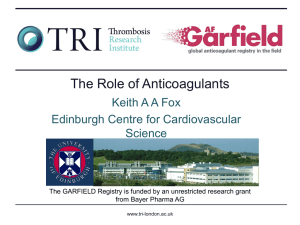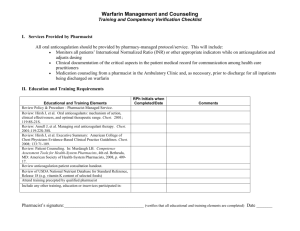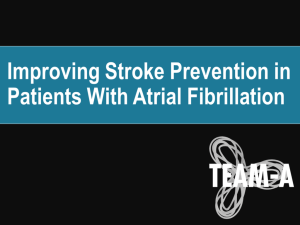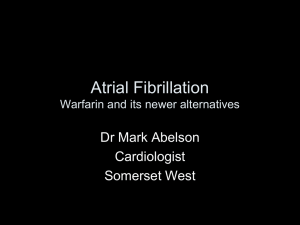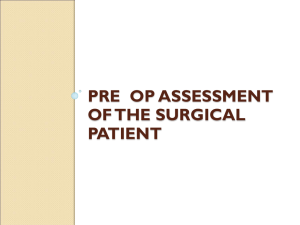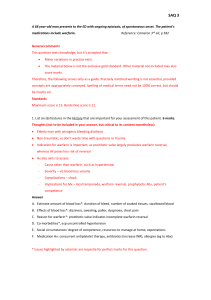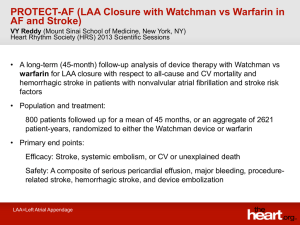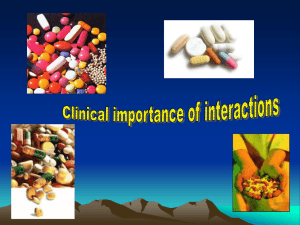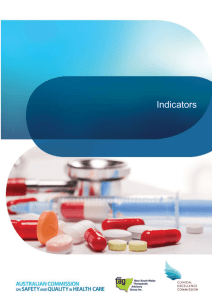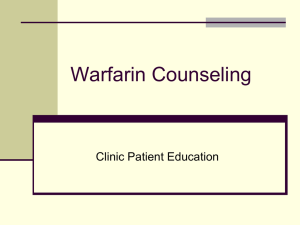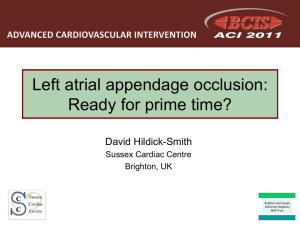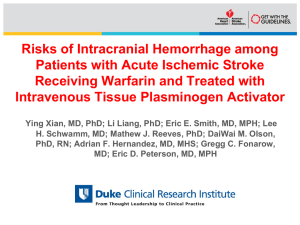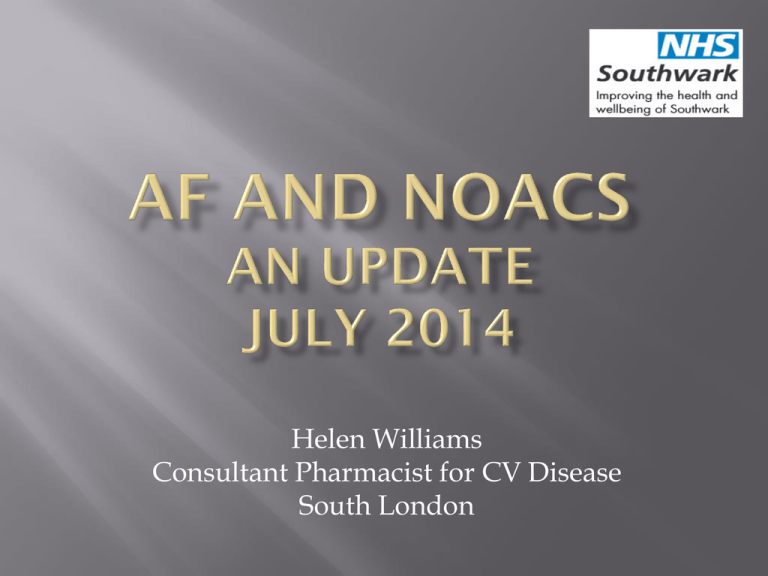
Helen Williams
Consultant Pharmacist for CV Disease
South London
AF is the leading - and
most preventable cause of embolic stroke
Risk increases with
age
Without preventive
treatment,
approximately 1 in 20
patients (5%) with AF
will have a stroke each
year
% of strokes
attributable to AF
25
20
15
%
10
5
0
50-59
60-69 70-79
Age (years)
80-89
Kannel WB et al. Am J Cardiol 1998; 82 (8A): 2N–9N.
Personalised package of care
Assessment of stroke and bleeding risk
Use of CHA2DS2-VASc and HASBLED
Anticoagulation with warfarin or a NOAC
Stop using aspirin for stroke prevention in
AF
Rate and rhythm control
Specialist referral and interventions where first
line options fail to manage symptoms
adequately
• Congestive heart failure/
LV dysfunction
• Hypertension
• Age 75
• Diabetes mellitus
• Stroke/TIA/TE
• Vascular disease
(CAD, CArD, PAD)
• Age 65-74
• Sex category (female)
1
Score
1
2
1
2
1
Annual stroke
rate, %
0
0
1
1.3
2
2.2
3
3.2
4
4.0
5
6.7
6
9.8
7
9.6
8
6.7
9
15.2
1
1
Score 0 – 9
Validated in 1084 NVAF patients not on OAC
with known TE status at 1 year in Euro Heart
Survey
OR for stroke if: Female: 2.53 (1.08 – 5.92), p=0.029;
Vascular disease: 2.27 (0.94 – 5.46), p=0.063
• Hypertension (current)
• Abnormal renal/liver function
• Stroke
• Bleeding
• Labile INR
• Elderly (age > 65 years)
• Drugs or alcohol
1
1/2
1
1
1
1
c-statistic 0.72 (similar to HEMORR2HAGES)
0.91 vs 0.85 for patients on ASA or no therapy
Intermediate
1/2
Score 0 – 9
Validated in 3978 NVAF patients with known TE
status at 1 year in Euro Heart Survey
Low
High
Score
Bleeds per
100 patientyears
0
1.13
1
1.02
2
1.88
3
3.74
4
8.70
c-statistic 0.72
Pisters R, et al. Chest 2010;138:1093-100
Aspirin is as effective as oral anticoagulation
Aspirin is safer than oral anticoagulation
Falls are a C/I to anticoagulant therapy
Prior GI bleeds are a C/I to anticoagulation
Up to 15% of patients cannot take
warfarin due to allergy, contraindication
or inability to manage the monitoring
requirements.
Up to 40% are not controlled within
therapeutic range on warfarin
Up to 45% with atrial fibrillation at high
stroke risk are not currently
anticoagulated – see QOF!
~4% uptake of NOACs in the UK market
Warfarin vs NOACs share (DOT)
100%
95%
90%
85%
80%
75%
70%
65%
60%
55%
50%
WARFARIN
1.
Data on file: Bristol-Myers Squibb Pharmaceuticals Limited
NOAC
DOT = Days on therapy
NOACs: Prioritizing Patients
…. And return on investment?
HIGH
= 7 strokes
prevented
PRIORITY
= 8 -16 strokes
prevented
£166k
£141 £282k
Patients unable to take
warfarin due to allergies / CI
and patients unable to
comply with monitoring of
warfarin (n=207)
Patients out of range
(n =252 – 501)
MEDIUM
PRIORITY
LOWER
PRIORITY
= 20 - 40 strokes
prevented
=3–5
strokes
prevented
Plus... up to
£915k for
currently
undetected AF
£505 £1,010k
£147k
£425£565k
What about costs?*
Patients on aspirin or
nothing (n= 629-1257)
New Patients (n=261)
Patients currently stable on
warfarin (n=756 – 1005)
* Annual costs based on a CCG
in South London, population
300k (prevalence = 0.9%)
An alternative to warfarin for SPAF in patients with
CHADS2 ≥ 1 who:
have a warfarin allergy, warfarin specific-contraindication
or are unable to tolerate warfarin therapy
are unable to comply with the specific monitoring
requirements of warfarin
are unable to achieve a satisfactory INR after an adequate
trial of warfarin
have had an ischaemic stroke whilst stable on warfarin
therapy
are unwilling to take warfarin after a full discussions of the
risks and benefits
Warfarin is a suitable first-line option for many
patients
Initiation by clinicians with ‘expertise in initiating
anticoagulation’
Initiating clinician responsible for at least first 3
months of therapy:
Address side effects
Emphasise importance of adherence
Transfer to patients own GP when ‘stable’ and in
line with approved indications
Check indication – AF, VTE treatment or prophylaxis
Check patient age – dose adjustment at 80 years with
dabigatran
Check renal function
Not just eGFR
Calculate creatinine
clearance
Check for adverse effects
Dabigatran dyspepsia in up to 10% patients
Rivaroxaban / apixaban: headache / dizziness
Check adherence
No monitoring of bloods (except annual renal function) therefore
possible increased risk of non-adherence over time

